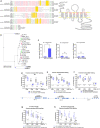Neuropeptidergic regulation of compulsive ethanol seeking in C. elegans
- PMID: 35110557
- PMCID: PMC8810865
- DOI: 10.1038/s41598-022-05256-1
Neuropeptidergic regulation of compulsive ethanol seeking in C. elegans
Abstract
Despite the catastrophic consequences of alcohol abuse, alcohol use disorders (AUD) and comorbidities continue to strain the healthcare system, largely due to the effects of alcohol-seeking behavior. An improved understanding of the molecular basis of alcohol seeking will lead to enriched treatments for these disorders. Compulsive alcohol seeking is characterized by an imbalance between the superior drive to consume alcohol and the disruption or erosion in control of alcohol use. To model the development of compulsive engagement in alcohol seeking, we simultaneously exploited two distinct and conflicting Caenorhabditis elegans behavioral programs, ethanol preference and avoidance of aversive stimulus. We demonstrate that the C. elegans model recapitulated the pivotal features of compulsive alcohol seeking in mammals, specifically repeated attempts, endurance, and finally aversion-resistant alcohol seeking. We found that neuropeptide signaling via SEB-3, a CRF receptor-like GPCR, facilitates the development of ethanol preference and compels animals to seek ethanol compulsively. Furthermore, our functional genomic approach and behavioral elucidation suggest that the SEB-3 regulates another neuropeptidergic signaling, the neurokinin receptor orthologue TKR-1, to facilitate compulsive ethanol-seeking behavior.
© 2022. The Author(s).
Conflict of interest statement
The authors declare no competing interests.
Figures








Similar articles
-
Neurobiological Basis of Aversion-Resistant Ethanol Seeking in C. elegans.Metabolites. 2022 Dec 31;13(1):62. doi: 10.3390/metabo13010062. Metabolites. 2022. PMID: 36676987 Free PMC article.
-
SEB-3, a CRF receptor-like GPCR, regulates locomotor activity states, stress responses and ethanol tolerance in Caenorhabditis elegans.Genes Brain Behav. 2013 Mar;12(2):250-62. doi: 10.1111/j.1601-183X.2012.00829.x. Epub 2012 Sep 4. Genes Brain Behav. 2013. PMID: 22853648 Free PMC article.
-
Ethanol preference in C. elegans.Genes Brain Behav. 2009 Aug;8(6):578-85. doi: 10.1111/j.1601-183X.2009.00513.x. Epub 2009 Jun 22. Genes Brain Behav. 2009. PMID: 19614755 Free PMC article.
-
Neuropeptide signaling network of Caenorhabditis elegans: from structure to behavior.Genetics. 2024 Nov 6;228(3):iyae141. doi: 10.1093/genetics/iyae141. Genetics. 2024. PMID: 39344922 Free PMC article. Review.
-
Nematodes feel a craving--using Caenorhabditis elegans as a model to study alcohol addiction.Neurosci Bull. 2014 Aug;30(4):595-600. doi: 10.1007/s12264-014-1451-7. Epub 2014 Jul 9. Neurosci Bull. 2014. PMID: 25008572 Free PMC article. Review.
Cited by
-
Redefining Representativeness of a Sample in Causal Terms.J Eval Clin Pract. 2025 Jun;31(4):e70137. doi: 10.1111/jep.70137. J Eval Clin Pract. 2025. PMID: 40545908 Free PMC article.
-
Neurobiological Basis of Aversion-Resistant Ethanol Seeking in C. elegans.Metabolites. 2022 Dec 31;13(1):62. doi: 10.3390/metabo13010062. Metabolites. 2022. PMID: 36676987 Free PMC article.
-
Evolutionary conserved peptide and glycoprotein hormone-like neuroendocrine systems in C. elegans.Mol Cell Endocrinol. 2024 Apr 15;584:112162. doi: 10.1016/j.mce.2024.112162. Epub 2024 Jan 28. Mol Cell Endocrinol. 2024. PMID: 38290646 Free PMC article.
-
Ethanol alters mechanosensory habituation in C. elegans by way of the BK potassium channel through a novel mechanism.PLoS One. 2025 Jun 11;20(6):e0315069. doi: 10.1371/journal.pone.0315069. eCollection 2025. PLoS One. 2025. PMID: 40498794 Free PMC article.
-
JNK Signaling Positively Regulates Acute Ethanol Tolerance in C. elegans.Int J Mol Sci. 2024 Jun 10;25(12):6398. doi: 10.3390/ijms25126398. Int J Mol Sci. 2024. PMID: 38928105 Free PMC article.
References
Publication types
MeSH terms
Substances
Grants and funding
LinkOut - more resources
Full Text Sources
Medical
Research Materials

